Experimental Study of Crack Propagation through Cladded 316L/S355 Steel Produced by the Hot-Roll Bonding Process
Abstract
:1. Introduction
2. Materials and Methods
2.1. Materials
2.2. Preparation of Plates, Hot Rolling, and Heat Treatment
2.3. Methods
3. Results and Discussion
3.1. Ultrasonic Testing
3.2. Macro- and Microstructure
3.3. Tensile Tests
3.4. Shear Tests
3.5. Instrumented Charpy Impact Test
3.5.1. Test Specimens after the Test
3.5.2. Results of the Instrumented Charpy Tests
3.6. Fracture Toughness
4. Conclusions
Author Contributions
Funding
Data Availability Statement
Conflicts of Interest
References
- Zhu, Z.C.; He, Y.; Zhang, X.J.; Liu, H.Y.; Li, X. Effect of interface oxides on shear properties of hot-rolled stainless steel clad plate. Mater. Sci. Eng. A 2016, 669, 344–349. [Google Scholar] [CrossRef]
- Song, H.; Shin, H.; Shin, Y. Heat-treatment of clad steel plate for application of hull structure. Ocean Eng. 2016, 122, 278–287. [Google Scholar] [CrossRef]
- Liu, B.X.; Yin, F.X.; Dai, X.L.; He, J.N.; Fang, W.; Chen, C.X.; Dong, Y.C. The tensile behaviors and fracture characteristics of stainless steel clad plates with different interfacial status. Mater. Sci. Eng. A-Struct. 2017, 679, 172–182. [Google Scholar] [CrossRef]
- Su, H.; Luo, X.B.; Chai, F.; Shen, J.C.; Sun, X.J.; Lu, F. Manufacturing Technology and Application Trends of Titanium Clad Steel Plates. J. Iron Steel Res. Int. 2015, 22, 977–982. [Google Scholar] [CrossRef]
- Fang, J.; Li, Y.Z. Process Optimization for Welding Stainless Steel clad material based on orthotropic bridge plates. Appl. Mech. Mater. 2012, 178–181, 2066–2069. [Google Scholar] [CrossRef]
- Ye, Y.; Zhang, S.J.; Han, L.H.; Liu, Y. Square concrete-filled stainless steel/carbon steel bimetallic tubular stub columns under axial compression. J. Constr. Steel Res. 2018, 146, 49–62. [Google Scholar] [CrossRef]
- Liu, J.G.; Wu, J.; Liu, Q.; Ji, S.; Zheng, X.L.; Wang, F.; Wang, J. Analysis of Cold Composite Sheet Rolling 572 Considering Anisotropic Effect and Position-Dependent Friction Model. Metals 2023, 13, 259. [Google Scholar]
- Li, Y.W.; Liu, H.T.; Wang, Z.J.; Zhang, X.M.; Wang, G.D. Suppression of edge cracking and improvement of ductility in high borated stainless steel composite plate fabricated by hot-roll-bonding. Mater. Sci. Eng. A-Struct. 2018, 731, 377–384. [Google Scholar] [CrossRef]
- Song, J.; Kostka, A.; Veehmayer, M.; Raabe, D. Hierarchical microstructure of explosive joints: Example of titanium to steel cladding. Mater. Sci. Eng. A 2011, 528, 2641–2647. [Google Scholar] [CrossRef]
- Wu, X.M.; Shi, C.G.; Fang, Z.H.; Lin, S.L.; Sun, Z.R. Comparative study on welding energy and Interface characteristics of titanium-aluminum explosive composites with and without interlayer. Mater. Des. 2021, 197, 109279. [Google Scholar] [CrossRef]
- Arab, A.; Guo, Y.S.; Zhou, Q.; Chen, P.W. Joining AlCoCrFeNi high entropy alloys and Al-6061 by explosive welding method. Vacuum 2020, 174, 109221. [Google Scholar] [CrossRef]
- Zhao, H. The Microstructure and Property of a Titanium-Carbon Steel Clad Plate Prepared Using Explosive Welding. Metals 2022, 12, 129. [Google Scholar] [CrossRef]
- Chen, Y.H.; Sun, S.W.; Zhang, T.M.; Zhou, X.W.; Li, S.H. Effects of post-weld heat treatment on the microstructure and mechanical properties of laser-welded NiTi/304SS joint with Ni filler. Mater. Sci. Eng. A 2020, 771, 138545. [Google Scholar] [CrossRef]
- Li, C.A.; Qin, G.L.; Tang, Y.S.; Zhang, B.G.; Lin, S.B.; Geng, P.H. Microstructures and mechanical 589 properties of stainless steel clad plate joint with diverse filler metals. J. Mater. Res. Technol. 2020, 9, 2522–2534. [Google Scholar] [CrossRef]
- Guo, K.; Gou, G.Q.; Lv, H.; Shan, M.L. Jointing of CFRP/5083 Aluminum Alloy by Induction Brazing: Processing, Connecting Mechanism, and Fatigue Performance. Coatings 2022, 12, 1559. [Google Scholar] [CrossRef]
- Rahmatabadi, D.; Pahlavani, M.; Gholami, M.D.; Marzbanrad, J.; Hashemi, R. Production of Al/Mg-Li composite by the accumulative roll bonding process. J. Mater. Res. Technol. 2020, 9, 7880–7886. [Google Scholar] [CrossRef]
- Rahmatabadi, D.; Tayyebi, M.; Najafizadeh, N.; Hashemi, R.; Rajabi, M. The influence of post-annealing and ultrasonic vibration on the formability of multilayered Al5052/MgAZ31B composite. Mater. Sci. Technol. 2021, 37, 78–85. [Google Scholar] [CrossRef]
- Wang, P.J.; Chen, Z.J.; Hu, C.; Li, B.X.; Mo, T.Q.; Liu, Q. Effects of annealing on the interfacial structures and mechanical properties of hot roll bonded Al/Mg clad sheets. Mater. Sci. Eng. A 2020, 792, 139673. [Google Scholar] [CrossRef]
- Rao, N.V.; Reddy, G.M.; Nagarjuna, S. Weld overlay cladding of high strength low alloy steel with austenitic 600 stainless steel—Structure and properties. Mater. Design 2011, 32, 2496–2506. [Google Scholar]
- Rezaii, A.; Shafiei, E.; Ostovan, F.; Daneshmanesh, H. Experimental & theoretical investigation of roll bonding process of multilayer strips by finite element method. J. Manuf. Process. 2020, 54, 54–69. [Google Scholar]
- Liu, B.X.; An, Q.; Yin, F.X.; Wang, S.; Chen, C.X. Interface formation and bonding mechanisms of hot-rolled stainless steel clad plate. J. Mater. Sci. 2019, 54, 11357–11377. [Google Scholar] [CrossRef]
- Zhao, Z.P.; Tang, J.R.; Tariq, N.U.; Liu, H.S.; Liu, H.H.; Ren, Y.P.; Tong, M.; Yin, L.S.; Du, H.; Wang, J.Q.; et al. Effect of rolling temperature on microstructure and mechanical properties of Ti/steel clad plates fabricated by cold spraying and hot-rolling. Mater. Sci. Eng. A 2020, 795, 139982. [Google Scholar] [CrossRef]
- EN 10025-2:2019; Hot Rolled Products of Structural Steels—Part 2: Technical Delivery Conditions for Non-Alloy Structural Steels. European Committee for Standardization: Brussels, Belgium, 2019; pp. 1–41.
- ASTM A240/240M-22A; Standard Specification for Chromium and Chromium-Nickel Stainless Steel Plate, Sheet, and Strip for Pressure Vessels and for General Applications. ASTM International: West Conshohocken, PA, USA, 2022; pp. 1–12.
- International Organization for Standardization. Preparation of Steel Substrates before Application of Paints and Related Products—Visual Assessment of Surface Cleanliness—Part 1: Rust Grades and Preparation Grades of Uncoated Steel Substrates and of Steel Substrates after Overall Removal of Previous Coatings; International Organization for Standardization: Geneva, Switzerland, 2007; pp. 1–74. [Google Scholar]
- ASTM A578/A578M–07; Standard Specifification for Straight-Beam Ultrasonic Examination of Rolled Steel Plates for Special Applications. ASTM International: West Conshohocken, PA, USA, 2008; pp. 1–5.
- ASTM A264-12(2019); Standard Specification for Stainless Chromium-Nickel Steel-Clad Plate. ASTM International: West Conshohocken, PA, USA, 2019; pp. 1–6.
- ISO 6506-1:2014; Metallic Materials-Brinell Hardness Test—Part 1: Test Method. International Organization for Standardization: Geneva, Switzerland, 2014; pp. 1–16.
- ISO 6344-3:2013; Coated Abrasives—Grain Size Analysis—Part 3: Determination of Grain Size Distribution of Microgrits P240 to P2500. International Organization for Standardization: Geneva, Switzerland, 2013; pp. 1–25.
- ISO/TR 16060:2003; Destructive Tests on Welds in Metallic Materials-Etchants for Macroscopic and Microscopic Examination. Organization for Standardization: Geneva, Switzerland, 2013; pp. 1–31.
- ASTM E407-07; Standard Practice for Microetching Metals and Alloys. ASTM International: West Conshohocken, PA, USA, 2007; pp. 1–22.
- EN ISO 6892-1:2019; Metallic Materials-Tensile Testing—Part 1: Method of Test at Room Temperature. European Committee for Standardization: Brussels, Belgium, 2019; pp. 1–87.
- ISO 148-1:2016; Metallic Materials-Charpy Pendulum Impact Test—Part 1: Test Method. International Organization for Standardization: Geneva, Switzerland, 2016; pp. 1–29.
- ASTM E1820-20; Standard Test Method for Measurement of Fracture Toughness. ASTM International: West Conshohocken, PA, USA, 2020; pp. 1–65.
- Seyffarth, P.; Meyer, B.; Scharff, A. Großer Atlas Schweiß-ZTU-Schaubilder; Deutscher Verlag für Schweißtechnik DVSVerlag GmbH: Dusseldorf, Germany, 1992. [Google Scholar]
- MatWeb Material Property Data-AISI Type 316L Stainless Steel, Annealed Plate. Available online: www.matweb.com/search/DataSheet.aspx?MatGUID=530144e2752b47709a58ca8fe0849969 (accessed on 25 May 2023).
- ASTM E399-22; Standard Test Method for Linear-Elastic Plane-Strain Fracture 646 Toughness of Metallic Materials. ASTM International: West Conshohocken, PA, USA, 2012; pp. 1–39.




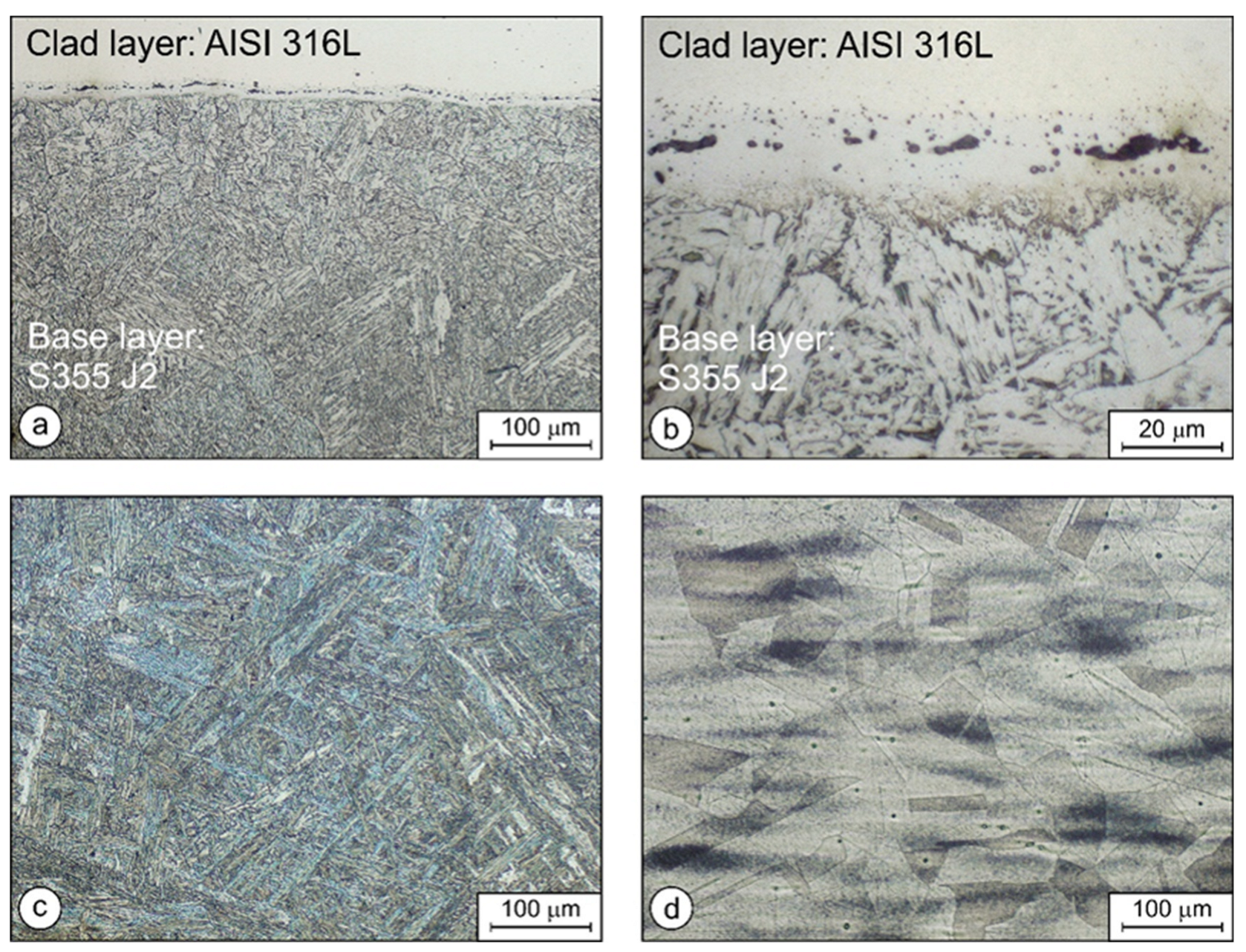

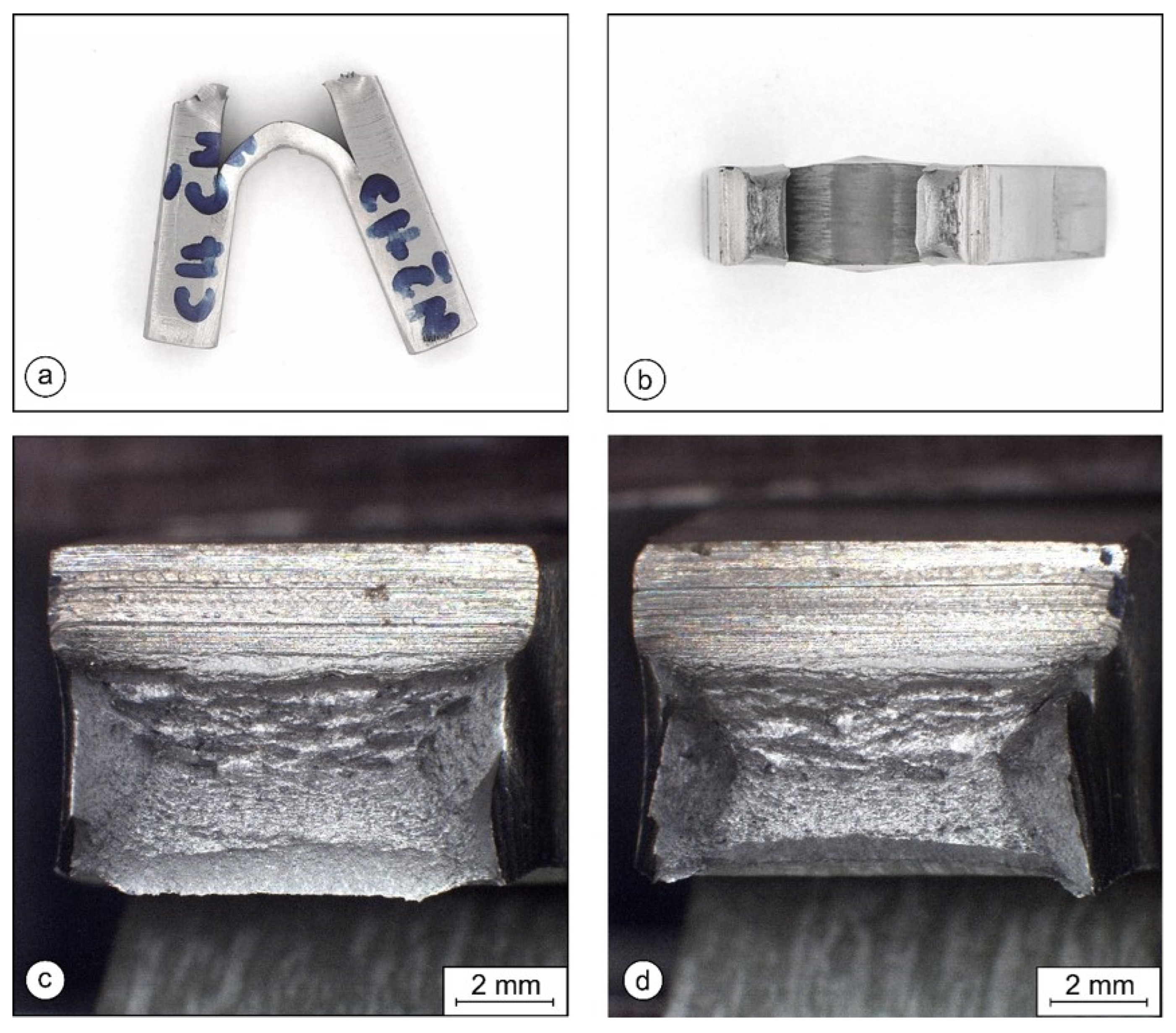
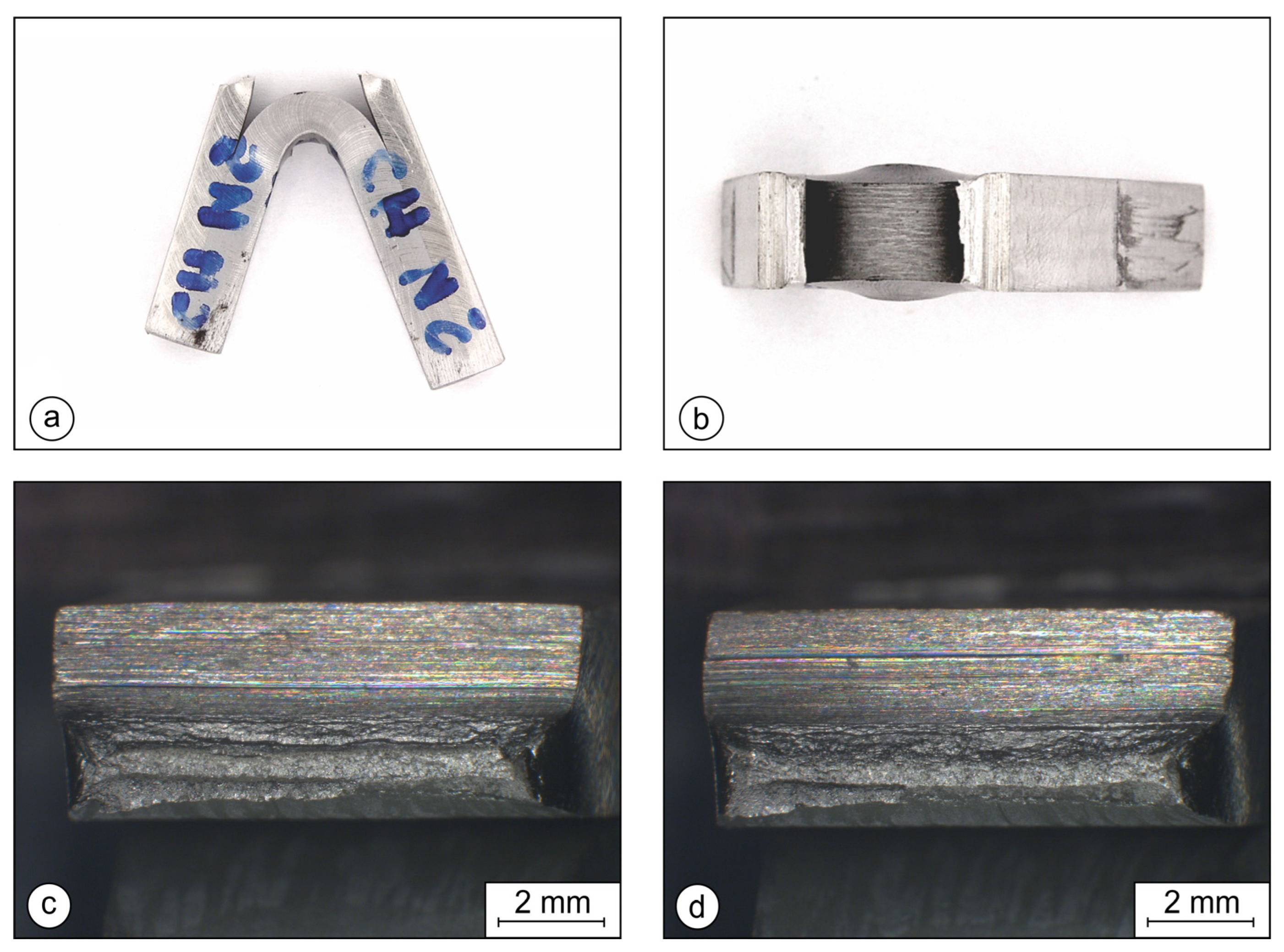

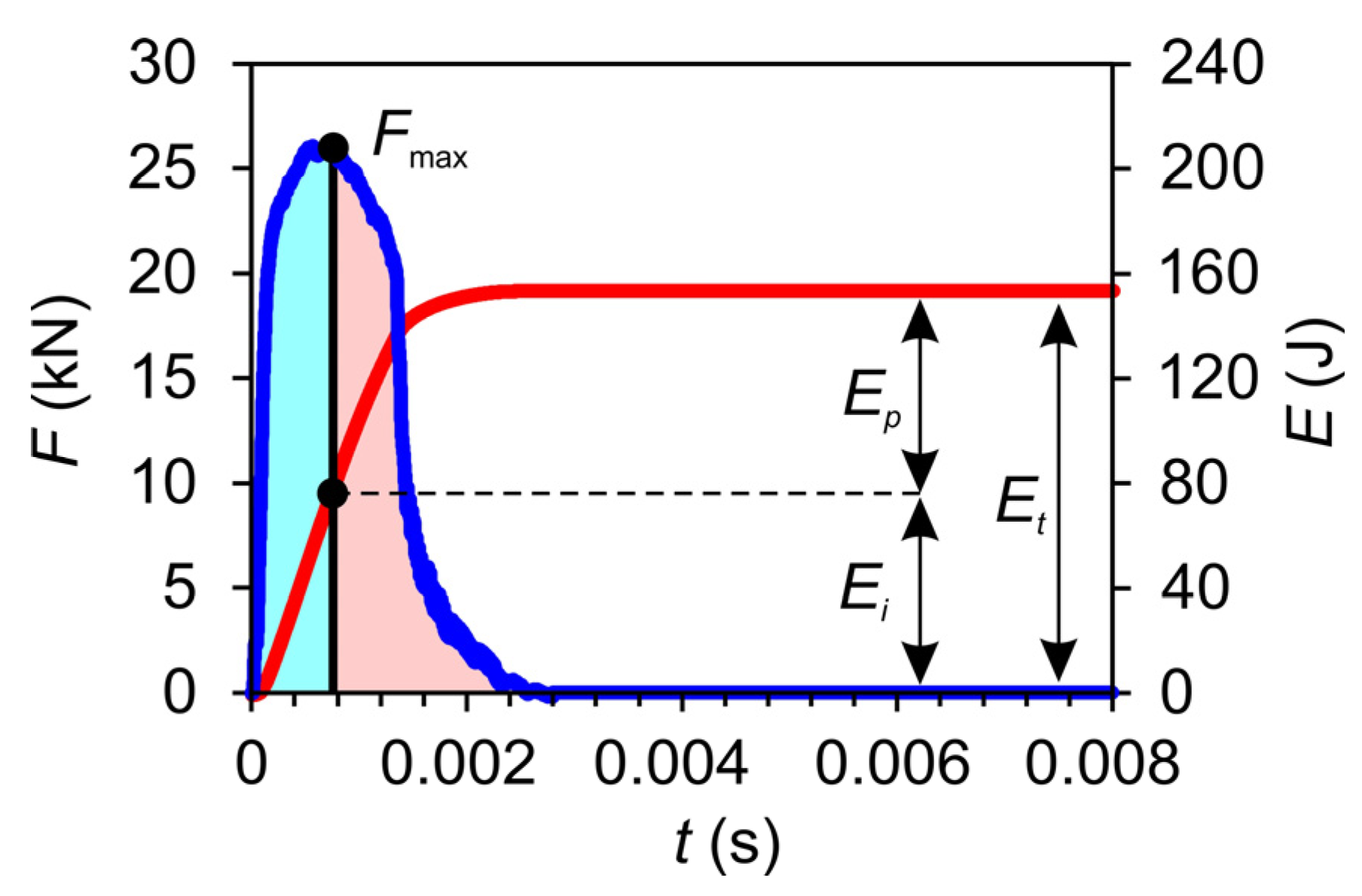

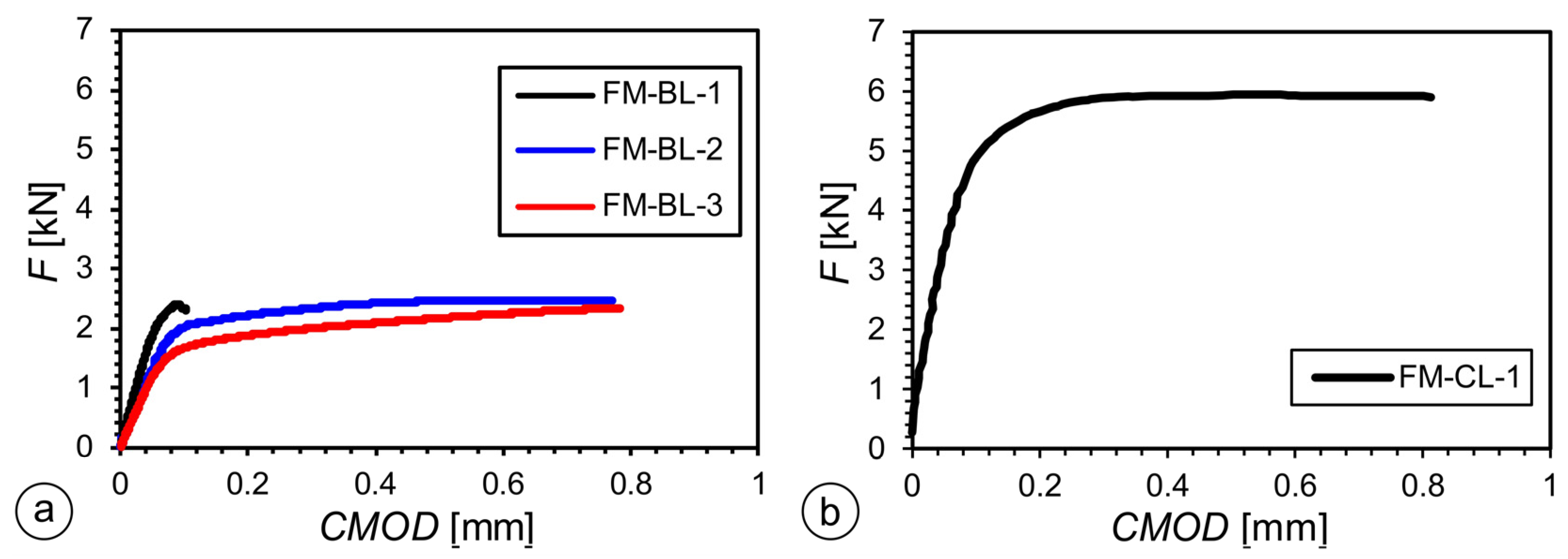
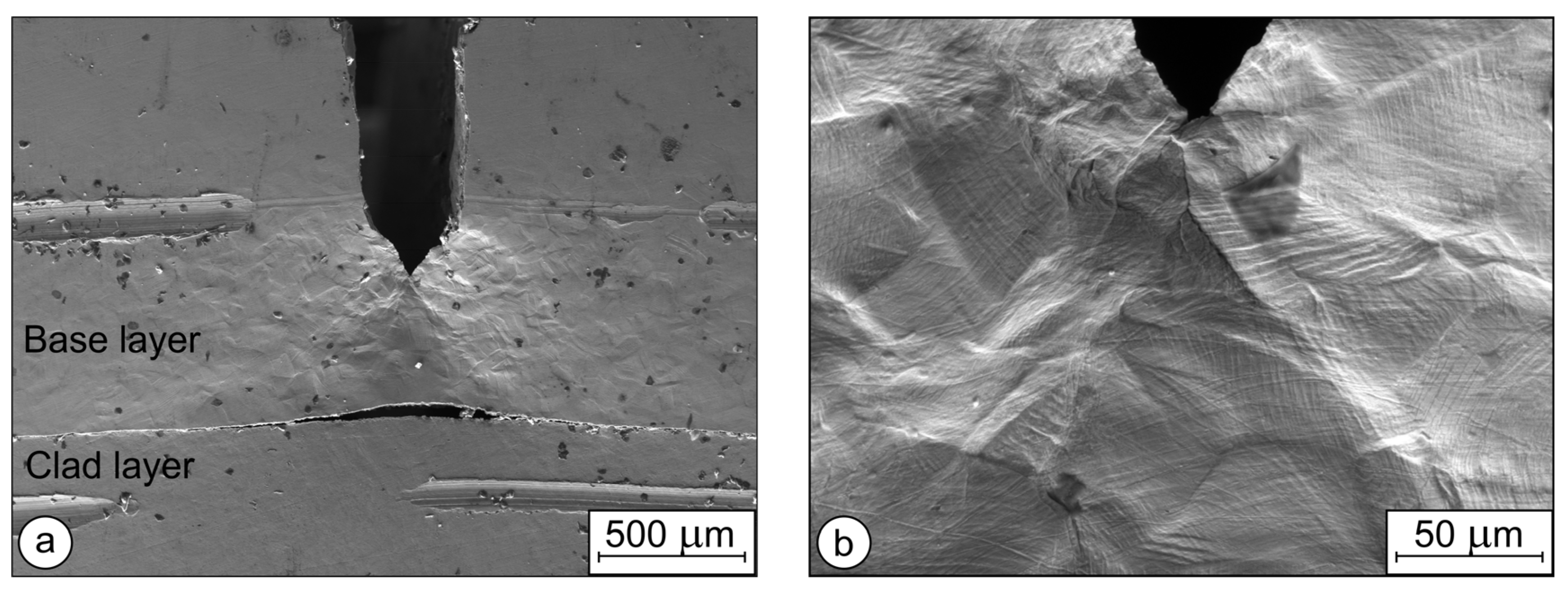

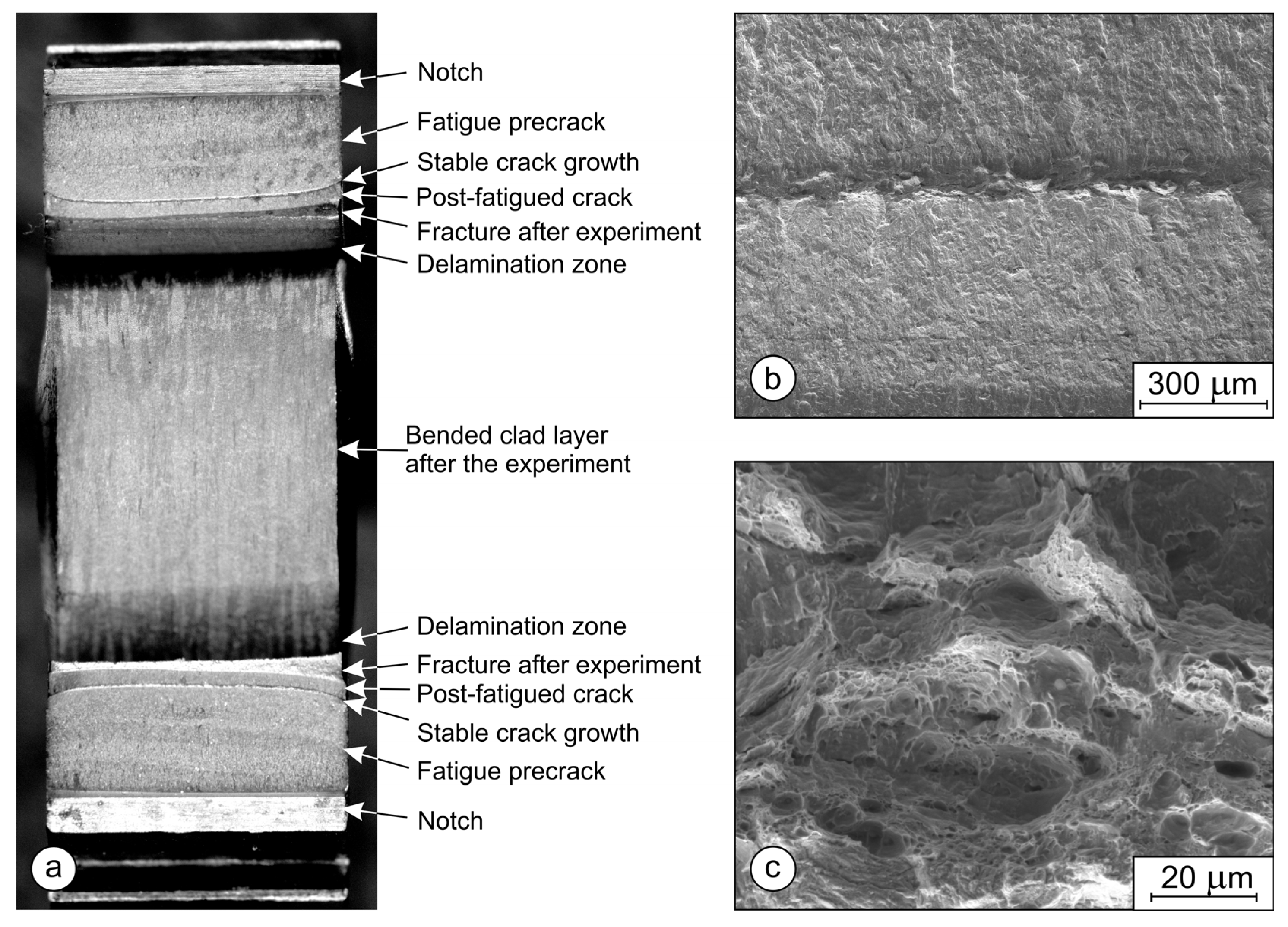

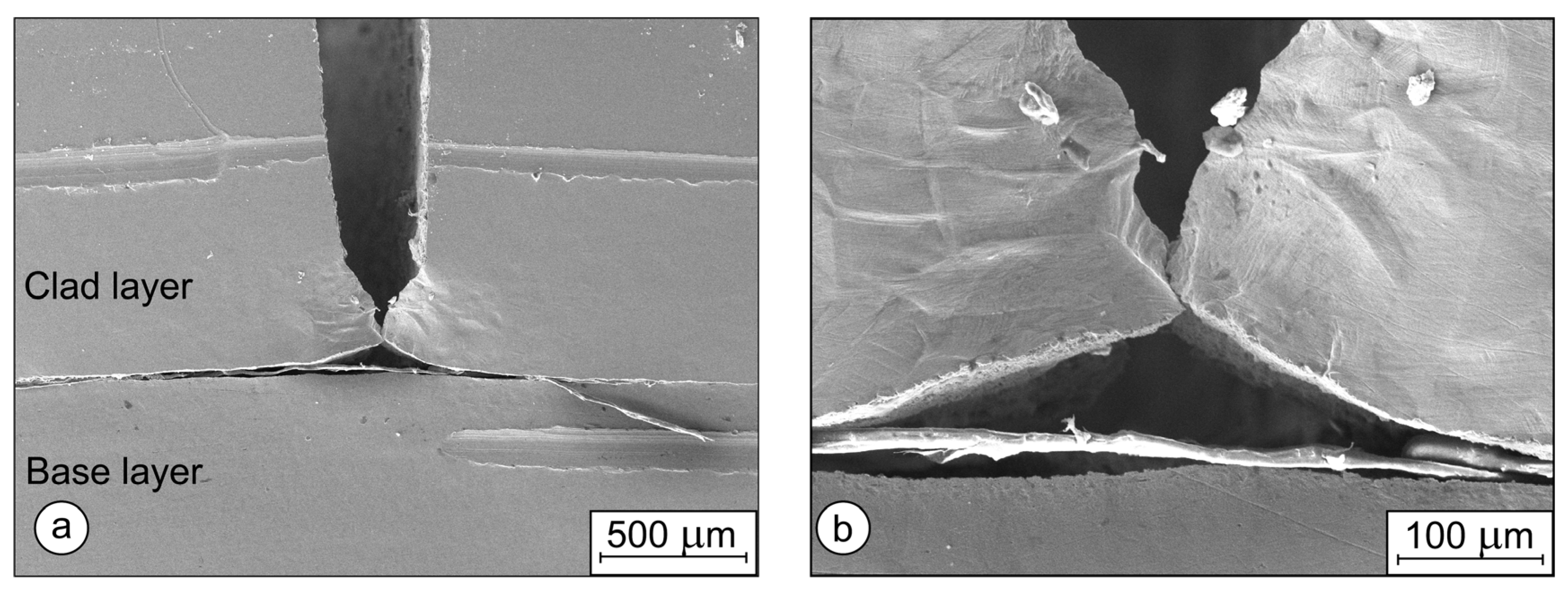
| Elements | C | Si | Mn | S | P | Cr | Ni | Cu | Al | Mo | V | Ti | Nb | W | N |
|---|---|---|---|---|---|---|---|---|---|---|---|---|---|---|---|
| S355 | 0.14 | 0.44 | 0.96 | 0.001 | 0.013 | 0.26 | 0.15 | 0.31 | 0.073 | 0.04 | 0.005 | 0.005 | 0.021 | 0.01 | 0.007 |
| AISI 316L | 0.03 | 0.37 | 1.62 | 0.001 | 0.035 | 16.75 | 10.22 | 0.31 | 0.074 | 2.02 | 0.100 | 0.005 | 0.009 | 0.12 | 0.044 |
| Package | Layer | Thickness (mm) | Width (mm) | Length (mm) |
|---|---|---|---|---|
| Package assembly | Base | 60 | 2160 | 2100 |
| Clad | 20 | 2060 | 2000 | |
| Clad | 20 | 2060 | 2000 | |
| Base | 60 | 2160 | 2100 |
| Pass Number | hei (mm) | Δh (mm) | δ (%) |
|---|---|---|---|
| 0 | 160 | 0 | 0 |
| 1 | 127 | 33 | 20 |
| 2 | 106 | 21 | 19 |
| 3 | 85 | 21 | 19 |
| 4 | 67 | 18 | 21 |
| 5 | 52 | 15 | 22 |
| 6 | 44 | 8 | 15 |
| 7 | 38 | 6 | 13 |
| 8 | 34 | 4 | 10 |
| 9 | 32 | 2 | 6 |
| Material | Type of Material | Direction of Testing | Rp0.2 (MPa) | Rm (MPa) | A5 (MPa) |
|---|---|---|---|---|---|
| S355 | Base layer before cladding | Rolling direction | 353 | 522 | 21 |
| 316L | Clad layer before cladding | Rolling direction | 218 | 542 | 62 |
| S355 | Base layer final | Rolling direction | 612 | 719 | 14 |
| 316L | Clad layer final | Rolling direction | 279 | 567 | 60 |
| S355/316L | Clad bond | Thickness direct. | - | 155 | - |
| Clad Bond | Shear Strength (MPa) |
|---|---|
| Oxide-rich area | 178 |
| Typical concentration of oxide particles | 363 |
| Layer | Material | Et = Ef + Eb [J] | Ef = Ei + Ep [J] | Ei (J) | Ep (J) | Eb (J) | At (mm2) |
|---|---|---|---|---|---|---|---|
| Base layer | S355 | 154.0 | 154.0 | 71.1 | 82.9 | 0 | 80.0 |
| Base layer/Clad layer | S355/316L | 170.5 | 136.1 | 72.8 | 63.3 | 34.4 | 45.6 |
| Clad layer/Base layer | 316L/S355 | 229.6 | 96.2 | 68.0 | 28.2 | 133.4 | 21.0 |
| Specimen Designation | Crack Tip in Material | Initial Crack Size a0 (mm) | Crack Propagation ∆a (mm) | Distance to Bond l (mm) | SIF at Delamination KQ (MPa·m0.5) | J Integral JQ (MPa/m2) |
|---|---|---|---|---|---|---|
| FM-BL-1 | S355 J2 | 5.122 | 0.041 | 0.735 | 32.58 | 5.99 |
| FM-BL-2 | S355 J2 | 5.127 | 0.004 | 0.653 | 32.18 | 41.41 |
| FM-BL-3 | S355 J2 | 5.985 | 0.079 | 0.993 | 41.98 | 40.47 |
| FM-CL-1 | AISI316L | 4.107 | 0.162 | 0.576 | 58.00 | 67.90 |
Disclaimer/Publisher’s Note: The statements, opinions and data contained in all publications are solely those of the individual author(s) and contributor(s) and not of MDPI and/or the editor(s). MDPI and/or the editor(s) disclaim responsibility for any injury to people or property resulting from any ideas, methods, instructions or products referred to in the content. |
© 2023 by the authors. Licensee MDPI, Basel, Switzerland. This article is an open access article distributed under the terms and conditions of the Creative Commons Attribution (CC BY) license (https://creativecommons.org/licenses/by/4.0/).
Share and Cite
Bjelajac, E.; Skumavc, A.; Smaili, F.; Lojen, G.; Predan, J.; Vuherer, T. Experimental Study of Crack Propagation through Cladded 316L/S355 Steel Produced by the Hot-Roll Bonding Process. Metals 2023, 13, 1273. https://doi.org/10.3390/met13071273
Bjelajac E, Skumavc A, Smaili F, Lojen G, Predan J, Vuherer T. Experimental Study of Crack Propagation through Cladded 316L/S355 Steel Produced by the Hot-Roll Bonding Process. Metals. 2023; 13(7):1273. https://doi.org/10.3390/met13071273
Chicago/Turabian StyleBjelajac, Edvard, Andrej Skumavc, Fidan Smaili, Gorazd Lojen, Jožef Predan, and Tomaž Vuherer. 2023. "Experimental Study of Crack Propagation through Cladded 316L/S355 Steel Produced by the Hot-Roll Bonding Process" Metals 13, no. 7: 1273. https://doi.org/10.3390/met13071273
APA StyleBjelajac, E., Skumavc, A., Smaili, F., Lojen, G., Predan, J., & Vuherer, T. (2023). Experimental Study of Crack Propagation through Cladded 316L/S355 Steel Produced by the Hot-Roll Bonding Process. Metals, 13(7), 1273. https://doi.org/10.3390/met13071273








